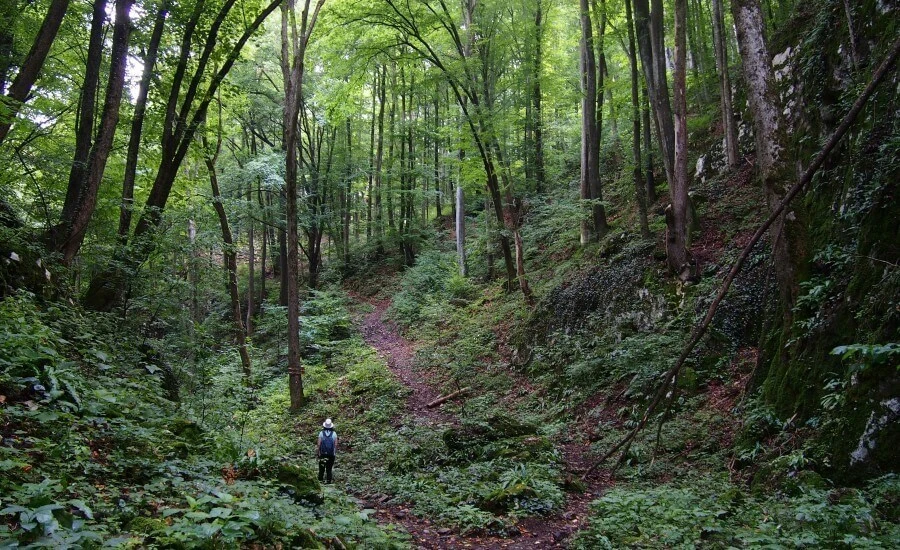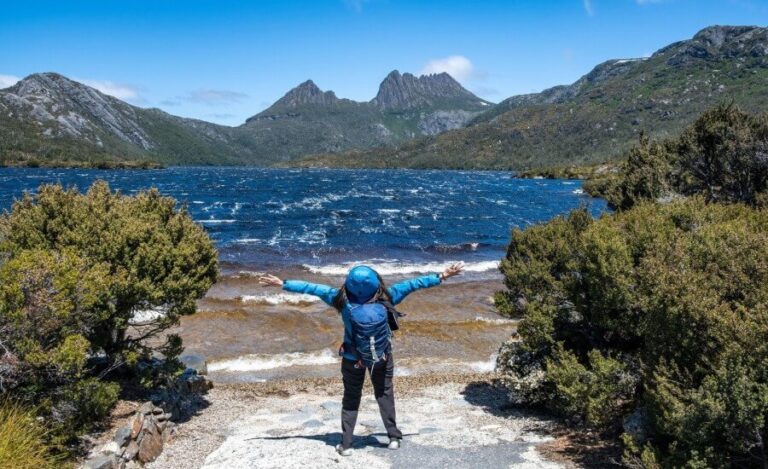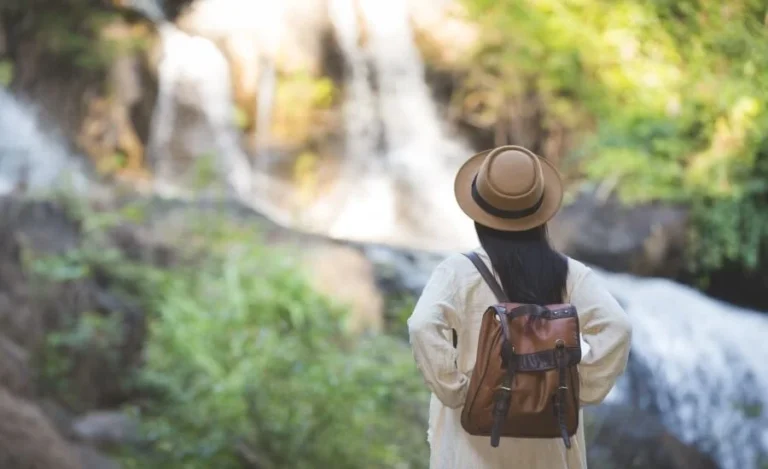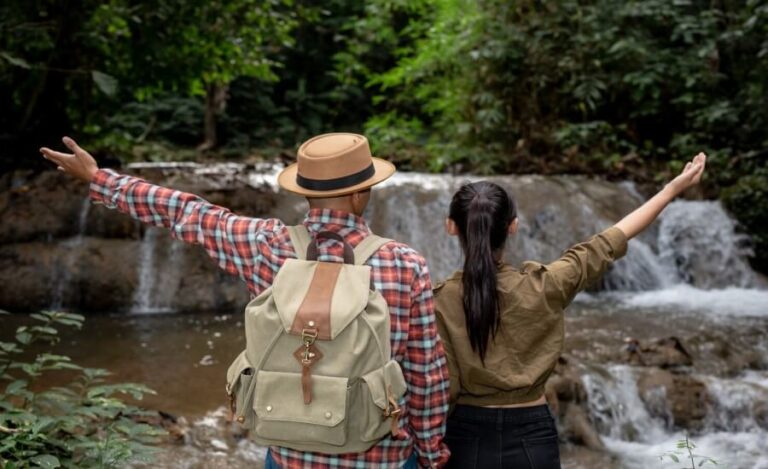
In a world where “fastest known times” and step-counting dominate outdoor culture, a quiet revolution is taking place on trails worldwide. Mindful trekking the practice of moving through landscapes with deliberate slowness and full sensory awareness offers an antidote to both urban acceleration and the achievement-oriented approach that has infiltrated even wilderness experiences.
This intentional deceleration transforms hiking from mere exercise or scenery consumption into a profound practice of presence. When we slow our pace, silence our devices, and engage all our senses, trails reveal dimensions invisible to the rushed traveler subtle ecological relationships, minute seasonal changes, and our own internal landscapes shifting in response to the natural world.
This guide explores extraordinary trails specifically suited to mindful trekking trails where natural features, cultural elements, and trekking trail design itself invite slowness rather than conquest. These aren’t necessarily the most famous routes, but each offers unique qualities that reward the unhurried traveler willing to experience rather than simply complete them.
In trading digital connections for natural ones and achievements for awareness, these journeys offer something increasingly precious: the opportunity to recalibrate our relationship with both the natural world and our own attention.
What Makes a Trail Perfect for Mindful Trekking?

Before exploring specific routes, understanding what qualities support mindful trekking helps explain why certain trekking trails particularly reward slow exploration.
Natural Rhythm-Setters
The most powerful mindful trekking routes contain natural features that inherently moderate pace—sections where rushing feels discordant with the environment itself. These might include:
- Dense forest canopies that create cathedral-like atmospheres naturally evoking quiet and slowness
- Stretches alongside rivers or streams where water sounds mask human noise and entrain brainwaves to more contemplative states
- High-elevation sections where reduced oxygen naturally slows physical movement
- Areas of particular ecological richness where abundant wildlife rewards patient observation
These environmental pace-setters gently counter our conditioned tendency toward hurry, creating what neuroscientists call “involuntary attention”—the effortless awareness that natural settings uniquely evoke.
Varied Sensory Landscapes
Trails that engage all senses—not just vision—naturally support mindfulness by pulling attention into the body and present moment. The most effective mindful trekking routes offer:
- Distinctive aromatic sections where plant compounds create natural aromatherapy
- Varied acoustic environments from sound-dampening forest to echo-creating canyons
- Diverse tactile experiences from smooth stone to soft forest floor
- Seasonal edibles that engage taste when appropriate
This sensory diversity counteracts the predominantly visual experience of digital life, reactivating perceptual capacities often dormant in everyday environments.
Cultural Touchpoints
Many of the world’s most powerful mindful trekking experiences incorporate cultural elements that invite reflection on human-nature relationships across time:
- Ancient pathways used for centuries or millennia
- Routes with spiritual or ceremonial significance in indigenous traditions
- Trails incorporating historical structures that demonstrate different human relationships with landscape
- Paths demonstrating traditional ecological knowledge through land management practices
These cultural dimensions add temporal depth to the spatial journey, creating natural invitations to consider our place in larger human-nature narratives extending beyond individual experience.
Best 7 Mindful Trekking Trails: Where Every Step Deepens Connection
1. The Old Growth Passage: Olympic Peninsula, Washington, USA

In northwestern Washington state lies one of North America’s most extraordinary forest experiences—a 15.5-mile loop trail through the Hoh Rainforest’s ancient ecosystem, where trees reaching 300 feet tall create a multi-layered canopy supporting one of the continent’s most complex temperate forest ecosystems.
The Mindful Experience from Mindful Trekking Trails
What makes this trail exceptional for mindful trekking is the natural pace moderation created by the forest itself. The extraordinary density of life—from the multiple canopy layers to the rich understory—creates overwhelming sensory richness that renders rushing physically uncomfortable and perceptually impossible. You simply cannot process what this environment offers at anything but the slowest pace.
The trail’s design brilliantly supports mindful engagement through alternating sections of dense forest immersion and small openings where light quality shifts dramatically, creating natural pauses in the journey. Several sections parallel small streams whose white noise creates what acoustic ecologists call “sound sanctuaries”—spaces where human-generated sounds (including your own) are naturally masked, supporting deeper listening to non-human voices in the landscape.
Practical Mindfulness with Mindful Trekking Trails
This trail particularly rewards these practices:
Vertical Awareness Meditation: Unlike most forests where attention naturally stays at eye level, the Hoh’s extreme vertical development invites a practice of systematic attention shifting from forest floor to mid-canopy to emergent crowns, developing awareness of the three-dimensional forest community often missed in conventional hiking.
Moisture Relationship: The Hoh receives over 140 inches of annual rainfall, creating extraordinary relationships with water visible in specialized plant adaptations, fungal networks, and moisture-dependent wildlife. Paying specific attention to how water moves through this ecosystem reveals ecological relationships invisible to casual observation.
Time-Scale Perspective: Trees here can exceed 1,000 years in age, with nurse logs demonstrating the multi-century process of decay and regeneration. Specific attention to these temporal markers provides direct encounter with time scales that counter the acceleration of digital culture.
Practical Considerations
The loop can be completed in 2-3 days, with several backcountry campsites available with permits from Olympic National Park. For deeper experience, consider extending to 4-5 days, allowing full days for sensory exploration from base camps rather than continuous movement.
The trail’s reasonable elevation profile (under 5,000 feet at its highest) makes it physically accessible to moderately fit trekkers, creating natural focus on perceptual rather than physical challenges. The temperate climate allows year-round access, though winter brings heavier rainfall requiring appropriate preparation.
The trail’s proximity to indigenous Coast Salish territories offers opportunities to learn about traditional relationships with this ecosystem before your journey, adding cultural depth to ecological observation.
2. The Ancient Tea Horse Road: Yunnan Section, China

In southwestern China’s Yunnan Province, portions of the ancient Tea Horse Road—a network of trade routes dating back over 1,000 years—offer extraordinary opportunities for mindful trekking that combines natural immersion with living cultural traditions. The section between Shaxi and Lijiang particularly rewards slow travel through terraced tea landscapes, traditional villages, and mountain ecosystems where contemporary communities maintain ancestral relationships with the land.
The Mindful Experience from Mindful Trekking Trails
What distinguishes this route for mindful trekking is the visible integration of human and natural systems developed over centuries of coevolution. Unlike trails through wilderness areas where human presence is minimized, this pathway demonstrates sustainable human-nature relationships maintained through daily practices rather than conservation policy.
The trail’s genius lies in its alternation between wild sections traversing mountain passes and cultural sections connecting traditional villages. This rhythm creates natural cognitive shifts between different attention modes—from ecological awareness in wild sections to cultural observation in village segments—preventing the attentional fatigue that can develop in unchanging environments.
Most powerfully, the route provides direct experience of tea cultivation landscapes representing some of humanity’s oldest managed ecosystems, where generations of careful tending have created environments of extraordinary biodiversity despite continuous human use.
Practical Mindfulness with Mindful Trekking Trails
This trail particularly rewards these practices:
Sensory Tea Engagement: The journey through active tea cultivation areas offers opportunities to develop what tea masters call “sensory vocabulary”—the ability to discern subtle flavor, aroma, and textural distinctions indicating specific relationships between plants, soil, and climate. Arranging tea tastings in villages along the route provides perceptual training that transfers to other sensory domains.
Morning Sound Mapping: Traditional villages along the route awaken with distinctive soundscapes combining nature sounds, household activities, and sometimes ceremonial elements. A practice of pre-dawn listening from the same location on consecutive days develops attentional capacity through comparative acoustic awareness.
Cultural-Ecological Observation: The traditional farmsteads maintaining centuries-old practices demonstrate sophisticated ecological knowledge through intercropping systems, water management, and forest relationship. Specific attention to these integrated systems reveals sustainability principles increasingly validated by contemporary science.
Practical Considerations
The route can be walked in 4-7 days depending on chosen section and pace, with accommodation available in village guesthouses operated by local families. These simple accommodations naturally limit digital connectivity while providing cultural immersion through home-cooked meals and occasional shared activities with host families.
While some sections reach elevations over 10,000 feet, the trail generally follows ancient trade routes designed for loaded horses, creating moderate grades accessible to reasonably fit trekkers. The subtropical highland climate makes spring (April-May) and autumn (September-October) ideal for comfortable hiking conditions.
Several local organizations arrange culturally appropriate introductions to minority communities along the route, providing crucial context while ensuring respectful engagement with traditional villages.
3. The Kumano Kodo: Kii Peninsula, Japan

On Japan’s Kii Peninsula south of Osaka, a network of ancient pilgrimage routes collectively known as the Kumano Kodo has connected sacred sites for over 1,000 years. The Nakahechi route particularly rewards mindful trekking through its combination of deep forest immersion, traditional villages, and sacred sites representing Japan’s unique religious synthesis of indigenous Shinto and imported Buddhist traditions.
The Mindful Experience from Mindful Trekking Trails
What makes this route exceptional for mindful trekking is its explicit design as a transformative journey rather than merely a connecting path. As a traditional pilgrimage route, the trail incorporates specific features intended to create progressive shifts in consciousness—from purification stages near trail beginnings, through increasingly charged sacred sites, to culminating experiences at major shrine complexes.
The route’s genius lies in its sophisticated use of natural features for contemplative purposes. Stone-paved sections require attention to each step, creating natural walking meditation. Periodic sacred trees marked with traditional shimenawa ropes create natural pauses in the journey. Stream crossings incorporate traditional purification elements. Even the challenging topography serves contemplative purposes, with ascents designed to create physical effort that naturally empties the chattering mind.
Most distinctively, the route demonstrates Japan’s tradition of shugendō—mountain asceticism that explicitly uses landscape features as tools for developing awareness and presence.
Practical Mindfulness with Mindful Trekking Trails
This trail particularly rewards these practices:
Torii Threshold Awareness: The traditional gates marking sacred space transitions offer natural opportunities for attention reset. A practice of pausing before and after passing through each torii, noting shifts in awareness, develops sensitivity to the often unconscious effects of thresholds in ordinary environments.
Sensory Season Mapping: The Japanese tradition of seasonal awareness (embedded in arts from poetry to cuisine) finds perfect expression on the Kumano Kodo, where subtle seasonal indicators—from particular bird calls to specific fungi appearances—reward deliberate attention to seasonal transition markers often missed by casual observation.
Dualistic Dissolution: The route’s shrines and temples physically demonstrate the Japanese religious synthesis that transcends Western nature/culture dualisms. Attention to how built elements incorporate rather than oppose natural features provides experiential understanding of non-dualistic awareness increasingly relevant to contemporary sustainability challenges.
Practical Considerations
The Nakahechi route typically requires 4-6 days, with accommodation available in traditional minshuku (family guesthouses) in villages along the way. These accommodations provide cultural immersion through traditional meals and sometimes hot spring bathing facilities that create natural evening rituals after walking days.
While mountain terrain creates challenging sections, the trail follows routes designed for ordinary pilgrims rather than ascetics alone, making it accessible to moderately fit trekkers comfortable with ascents and descents on sometimes uneven surfaces. The temperate climate allows comfortable trekking from April through November, with autumn (October-November) offering spectacular foliage displays.
As a UNESCO World Heritage route, excellent infrastructure exists for foreign trekkers, including dual-language signage and cultural interpretation materials that provide context for sacred sites along the way.
4. The Lycian Way: Southwestern Turkey

Along Turkey’s southwestern Mediterranean coast, a 335-mile waymarked path connects ancient Lycian civilization sites through spectacular coastal and mountain landscapes. While the full route requires several weeks, the 50-mile section between Fethiye and Kaş offers an ideal mindful trekking experience through its combination of ecological diversity, cultural depth, and natural pace moderation.
The Mindful Experience from Mindful Trekking Trails
What distinguishes this route for mindful trekking is its extraordinary temporal layering—the visible accumulation of human interaction with landscape across multiple civilizations from Lycian to Roman, Byzantine, Ottoman, and contemporary Turkish. Unlike more heavily reconstructed archaeological sites, the ruins along this path remain partially integrated into the landscape, creating powerful experiences of time’s passage and the impermanence of human constructions.
The trail’s genius lies in its alternation between coastal sections with expansive Mediterranean views and inland segments through traditional villages and pine forests. This rhythm naturally creates shifting attentional demands—from the hypnotic effect of ocean vistas to the detailed observation required in forest environments—preventing the perceptual fatigue that can develop in unchanging landscapes.
Perhaps most distinctively, the route demonstrates the Mediterranean region’s sophisticated agroecological systems, where human cultivation has created rather than diminished biodiversity through millennia of adaptive management.
Practical Mindfulness with Mindful Trekking Trails
This trail particularly rewards these practices:
Architectural Awareness Meditation: The route passes numerous structures from different historical periods, from ancient Lycian tombs to Byzantine churches to traditional Turkish village houses. A practice of systematic attention to how each building tradition relates to local environmental conditions reveals ecological wisdom often missed in conventional architectural appreciation.
Aromatic Engagement: The Mediterranean macchia (shrubland) contains one of the world’s highest concentrations of aromatic plants, with species like thyme, sage, and rosemary creating natural aromatherapy along the route. Specific attention to these changing scent profiles—and how they correspond to microhabitat conditions—develops olfactory awareness often underdeveloped in predominantly visual cultures.
Civilization Cycle Observation: The visible remains of multiple civilizations, each with its own relationship to the landscape, creates natural reflection on cycles of human development often obscured in more actively maintained historical sites. This temporal perspective offers powerful antidote to the presentism of digital culture.
Practical Considerations
The Fethiye to Kaş section typically requires 5-7 days of walking, with accommodation available in a combination of small pensions in villages and occasional beach camping in more remote sections. This accommodation mix creates an ideal rhythm of cultural engagement and natural immersion.
The coastal terrain creates moderate physical challenge, with some significant ascents and descents but generally well-maintained trails accessible to reasonably fit trekkers. The Mediterranean climate makes spring (April-May) and autumn (September-October) ideal for comfortable hiking conditions, avoiding both summer heat and winter precipitation.
The route’s popularity with Turkish weekenders creates opportunities for cultural exchange not available on more tourist-oriented trails, particularly in village sections where local food traditions add sensory richness to the journey.
5. The Overland Track: Tasmania, Australia

In the heart of Tasmania’s World Heritage Wilderness, the 40-mile Overland Track traverses one of the Southern Hemisphere’s most pristine temperate wilderness areas. While popular as a 6-day through-hike, the trail’s design with side-route options and well-placed huts makes it ideal for extended mindful trekking that allows deeper engagement with its remarkable ecological diversity.
The Mindful Experience from Mindful Trekking Trails
What makes this route exceptional for mindful trekking is its showcase of Gondwanan ecology—plant communities with direct evolutionary links to the ancient supercontinent that began breaking apart 180 million years ago. This living connection to deep time creates natural deceleration of perceived time, as daily movement traverses evolutionary landscapes spanning millions of years.
The trail’s genius lies in its traversal of multiple distinct ecosystems within a relatively short distance—from rainforest to alpine moorland, button grass plains to eucalypt woodlands—creating natural attentional refreshment as perceptual demands shift between these dramatically different environments.
Most distinctively, the route’s remoteness and strict management (with limited daily entries) creates what sensory researchers call “sonic wilderness”—one of the increasingly rare environments without mechanical sound intrusion, where natural soundscapes remain intact enough to demonstrate acoustic ecology principles functioning as they evolved over millennia.
Practical Mindfulness with Mindful Trekking Trails
This trail particularly rewards these practices:
Evolutionary Awareness: The presence of plant species virtually unchanged for millions of years, like the ancient King Billy pine and deciduous beech, offers opportunities for what deep ecologists call “evolutionary remembering”—conscious connection with the deep time processes that shaped both landscapes and human perception systems. Specific attention to these ancient species develops temporal perspective rarely accessible in more human-modified environments.
Weather Relationship Practice: The track’s alpine sections experience some of the world’s most rapidly changing weather conditions, creating natural opportunities to develop what indigenous cultures call “weather sense”—the ability to read subtle environmental cues indicating imminent changes. This perceptual training has applications far beyond wilderness contexts.
Night Sky Immersion: The combination of high elevation, dry air, and absence of light pollution creates extraordinary night sky visibility. Practices of systematic constellation identification, celestial navigation basics, and simply tracking moon movement develop observational skills increasingly lost in artificially illuminated environments.
Practical Considerations
While typically walked in 6 days, extending to 8-10 days by incorporating side trips and rest days creates ideal conditions for mindful engagement. The track features public huts at day-hike intervals, but carrying camping equipment allows flexibility for extended stays in particularly compelling locations.
The alpine environment creates significant physical challenges, with unpredictable weather and sometimes difficult trail conditions requiring good physical preparation and appropriate equipment. The Tasmanian Parks service limits daily entries and requires advance bookings, creating natural crowd limitations that support contemplative experience.
The region’s significance to Tasmanian Aboriginal peoples adds cultural depth to ecological observation, with opportunities to learn about traditional relationships with this landscape before beginning the journey.
6. The Paine Circuit: Torres del Paine, Patagonia, Chile

In Chilean Patagonia’s iconic Torres del Paine National Park, the 80-mile Circuit Trek (O Circuit) circumnavigates the Paine Massif through a landscape of extraordinary geological drama. While often approached as an athletic challenge, the route’s design with strategically placed campsites makes it ideal for extended mindful trekking that allows deep engagement with one of Earth’s most dynamic landscapes.
The Mindful Experience from Mindful Trekking Trails
What distinguishes this route for mindful trekking is its demonstration of geological processes usually accessible only through conceptual understanding. Here, glacial carving, tectonic uplift, and erosional processes are viscerally visible rather than merely intellectual concepts, creating embodied understanding of Earth’s dynamism rarely accessible in human timeframes.
The trail’s genius lies in its circular route, which creates a natural container for experience while demonstrating how dramatically perspective changes when viewing the same features from different angles. This physical lesson in perspective-taking has natural applications to cognitive flexibility in everyday life.
Most powerfully, the route traverses one of the planet’s most dramatic climate transition zones, where the Southern Patagonian Ice Field—the world’s third-largest freshwater reserve—meets arid steppe in the rain shadow just miles away. This extreme adjacency makes climate dynamics tangible rather than abstract.
Practical Mindfulness with Mindful Trekking Trails
This trail particularly rewards these practices:
Geological Time Meditation: The visible layers in the Paine Massif’s distinctive rock formations span over 12 million years of Earth history. A practice of systematically observing these layers while contemplating their formation timescales develops temporal perspective that naturally counters the compressed time experience of digital culture.
Wind Relationship Practice: The region’s famous winds, which can reach over 100mph, create opportunities for what ecological philosophers call “elemental thinking”—direct sensory engagement with primary forces typically abstracted in contemporary life. Safely experiencing these winds develops awareness of human scale within planetary systems.
Ecological Edge Awareness: The dramatic meeting of multiple ecosystems—glacial, alpine, forest, and steppe—creates abundant edge habitats where ecological principles become particularly visible. Attention to how species adapt to these transition zones provides insight into resilience strategies relevant far beyond wilderness contexts.
Practical Considerations
While typically walked in 7-10 days, extending to 12-14 days by incorporating rest days at strategic campsites creates ideal conditions for mindful engagement without requiring exceptional physical fitness. The trail’s popularity requires advance booking of campsites, but its circular design distributes trekkers around its length, allowing for periods of relative solitude even during high season.
The extreme Patagonian climate creates significant challenges, with high winds and rapidly changing conditions requiring appropriate equipment and preparation. The summer season (December-February) offers the most stable conditions, though shoulder seasons provide fewer crowds for those prepared for more challenging weather.
The region’s complex land use history—from indigenous Tehuelche territory to sheep estancia to national park—offers opportunities for considering changing human-nature relationships in a landscape shaped by multiple cultural approaches.
7. The Cordillera Huayhuash Circuit: Peru

In Peru’s Cordillera Huayhuash, a compact but extraordinarily vertical mountain range, the 80-mile circuit trek passes through some of the Andes’ most dramatic high-altitude landscapes. While requiring significant acclimatization and physical preparation, the route offers unparalleled opportunities for mindful engagement with high mountain environments and the indigenous communities maintaining traditional relationships with these extreme landscapes.
The Mindful Experience from Mindful Trekking Trails
What makes this route exceptional for mindful trekking is the natural attentional focus created by high-altitude environments. The reduced oxygen above 14,000 feet (where much of the circuit occurs) necessitates deliberate movement and breathing awareness, creating what Andean peoples call “mountain consciousness”—a distinctive state where perception naturally sharpens as physical capacity reduces.
The trail’s brilliance lies in its traversal of multiple microclimates within very short distances due to extreme elevation changes, creating what ecologists call “vertical islands” where evolutionary processes have produced highly specialized adaptations. This ecological compression makes relationships between environment and adaptation visible in ways rarely accessible in more homogeneous landscapes.
Most distinctively, the route passes through areas where Quechua communities maintain traditional vertical agriculture and pastoralism systems, demonstrating sustainable high-altitude human-nature relationships developed over thousands of years of careful observation and adaptation.
Practical Mindfulness with Mindful Trekking Trails
This circuit particularly rewards these practices:
Altitude Awareness Meditation: The physiological changes required for high-altitude adaptation create natural opportunities for body awareness practices. Systematic attention to breathing patterns, heart rate, and energy levels develops somatic awareness applicable in many other contexts while ensuring safer adaptation to elevation.
Water Origin Contemplation: The circuit passes dozens of glacial lakes and streams that form the headwaters of Amazon tributaries, creating tangible connection with continental water systems often conceptualized only abstractly. Following water from glacier to stream to river develops systems thinking through direct observation.
Cultural Adaptation Observation: The traditional communities along sections of the route demonstrate sophisticated adaptations to high-altitude constraints through agricultural techniques, architectural practices, and social organization. Attention to these adaptation patterns reveals sustainability principles increasingly relevant to contemporary challenges.
Practical Considerations
The circuit typically requires 10-14 days, with camping in established sites near local communities that sometimes offer basic supplies and occasionally simple accommodation alternatives. The route’s remoteness creates natural immersion uninterrupted by connectivity or infrastructure.
The extreme altitude (with passes reaching over 16,000 feet) creates significant physical challenges requiring thorough acclimatization and appropriate preparation. The dry season (May-September) offers most stable conditions, though even then, mountain weather remains unpredictable and sometimes severe.
Community-based trekking associations can arrange local guides and pack animals, providing both logistical support and cultural interpretation while ensuring economic benefits reach local communities rather than distant operators.
Mindful Engagement: Practices for Deepening Trekking Experiences
Regardless of which trail you choose to explore, certain practices enhance the transformative potential of mindful trekking while naturally reducing technological dependency:
The Sensory Activation Sequence
Modern life’s sensory imbalance—predominantly visual with significant auditory input but minimal engagement of other senses—creates perceptual patterns that mindful trekking can rebalance:
- Begin each trekking day with a deliberate sensory activation sequence:
- Two minutes of eyes-closed listening, identifying as many distinct sounds as possible
- One minute focused on air movement against skin, noting temperature, moisture, and subtle pressure changes
- One minute attending to ground contact through feet, noting texture, firmness, and temperature
- One minute noting ambient scents, both obvious and subtle
- One minute observing visual details at three scales: immediate foreground, middle distance, and far horizon
- Repeat this sequence at midday and evening, noting how sensory information changes throughout the day
This practice counteracts the predominantly visual bias of both digital culture and conventional hiking, where stunning views often dominate subtler sensory information.
The Walking Rhythm Meditation
Traditional pilgrimage cultures worldwide have developed walking practices that transform movement itself into meditation:
- Establish awareness of your natural walking rhythm without attempting to change it
- Gradually synchronize breath with steps using patterns appropriate to terrain:
- On level ground: 3 steps per inhale, 3 steps per exhale
- On ascents: 2 steps per inhale, 3 steps per exhale
- On descents: 3 steps per inhale, 2 steps per exhale
- When comfortable with breath-step synchronization, add awareness of ground contact, noting the three phases of each step (heel strike, mid-foot, toe-off)
- If appropriate, experiment with traditional mantras or counting patterns that further enhance rhythmic awareness
This practice transforms walking from mere transportation into a concentration tool that naturally reduces mental chatter while developing awareness of both internal and external rhythms.
The Threshold Crossing Ritual
Indigenous traditions worldwide recognize the importance of conscious transitions between different environments:
- Identify significant thresholds along your route—mountain passes, ecosystem boundaries, water crossings, or symbolic markers
- Develop a personal ritual for crossing these thresholds, which might include:
- Pausing for three conscious breaths before crossing
- Physically touching the threshold (a pass marker, a distinctive rock, the water’s edge)
- Speaking or thinking an intention for the next section of journey
- Leaving a small, biodegradable token of appreciation
- After crossing, pause again to notice any shifts in your internal state
- Consider recording these transitions and associated perceptions in a dedicated journal section
This practice heightens awareness of both external landscape changes and internal responses, creating more integrated experiences than continuous movement allows.
Common Concerns & Solutions for Mindful Trekking

“I’m concerned about basic safety while moving slowly and paying attention to surroundings rather than the trail.”
Solution: This valid concern reflects how conventional hiking often prioritizes technical attention (to footing, navigation, timing) over broader awareness. The key lies not in choosing between safety and presence but in developing rhythmic alternation between focused attention and expanded awareness. Practice “pulse attention”—periods of specific focus on technical needs (trail conditions, navigation checks, weather assessment) alternating with periods of broader sensory engagement once immediate needs are secured.
Practically, this might mean stopping completely for broader awareness practices rather than attempting them while moving over difficult terrain, or establishing regular intervals for explicit safety checks within a more contemplative approach. Most importantly, mindful trekking does not mean abandoning appropriate preparation and skill development—indeed, solid technical capabilities create the foundation that allows attention to expand beyond immediate safety concerns.
“How do I balance solitude for mindfulness with the safety of group travel?”
Solution: This common tension can be addressed through thoughtful group practices rather than seeing it as an either/or situation. Consider establishing explicit “solo zones” within group journeys—perhaps walking within sight but out of conversation range during certain trail sections, or creating a daily solo hour where group members scatter to individual sitting spots within a defined area.
Develop simple communication signals that allow essential safety information to be shared without unnecessary conversation. Most importantly, discuss mindfulness intentions before the journey begins, establishing shared understanding of when conversation is welcome and when silence is preferred. Many traditional pilgrimage routes developed specific protocols for precisely this balance—periods of social connection alternating with contemplative silence—that modern groups can adapt for contemporary mindful trekking.
“I want to document beautiful experiences but find photography pulls me out of direct experience.”
Solution: This challenge intensifies in photogenic natural environments where documentation impulses can create exactly the perceptual distance you’re attempting to overcome. Consider alternative documentation approaches: field sketching (regardless of artistic skill) creates memory anchors through the attention required; audio journaling captures both observations and environmental sounds; written descriptions focusing on non-visual senses preserve dimensions photography misses.
If using cameras, establish specific, limited “documentation windows” (perhaps 15 minutes morning and evening) rather than continuous shooting. Most importantly, explicitly designate certain experiences as completely undocumented—perhaps the most beautiful viewpoint or most powerful location—experiencing firsthand how abstaining from recording affects your perception and memory formation.
“I’m not sure I can disconnect completely from responsibilities while trekking.”
Solution: Complete disconnection isn’t necessary for meaningful mindful trekking. The key lies in creating clear boundaries through both temporal and spatial containment. Consider establishing specific, limited times for device use when necessary—perhaps 15 minutes each evening for essential communication. Create physical separation by designating specific locations for connectivity rather than maintaining constant availability.
Pack physical signal blockers like simple Faraday pouches that require deliberate action to reconnect. Most importantly, prepare both yourself and others through clear communication about your reduced availability and appropriate emergency protocols. The constraint of limited connectivity often reveals how few messages actually require immediate response, while the contrast between connected and unplugged states heightens awareness of how digital engagement affects your perception and presence.
Before You Go: The Mindful Trekking Preparation Checklist

Essential Preparations:
- Research your chosen trail’s ecological and cultural contexts beyond basic logistics
- Learn about indigenous relationships with your selected landscape where applicable
- Develop specific mindfulness intentions for your journey beyond general presence
- Prepare appropriate safety equipment and skills for your chosen environment
- Establish reasonable daily distances that allow for exploratory pauses
- Learn basic natural history of key species you’re likely to encounter
- Understand appropriate local protocols for sacred or culturally significant sites
- Prepare a dedicated journal with sections for different observation categories
- Learn about seasonal changes and phenomena you might witness
- Develop specific questions or curiosities to investigate through direct observation
- Research traditional ecological knowledge relevant to your route if available
- Consider reading accounts from contemplative travelers in similar landscapes
Digital Mindfulness Strategy:
- Establish clear communication expectations with people at home
- Pre-download essential navigation information for offline access
- Consider a basic phone rather than smartphone for emergency communication
- Prepare power management strategy appropriate to your journey length
- Create specific, limited windows for any necessary digital documentation
- Prepare non-digital alternatives for activities you typically use technology for
- Set up an auto-response system for non-urgent communications
- Consider a complete digital fast for at least a portion of your journey
- Prepare analog documentation tools—journal, sketching materials, non-digital camera
Bringing the Trail Home: Integrating Mindful Awareness into Everyday Life

The most valuable outcomes of mindful trekking emerge not during the journey itself but in how these experiences transform everyday awareness after returning:
Create Nature Connection Rituals
Even in urban environments, regular nature connection practices sustain the perceptual shifts developed through mindful trekking:
- Establish a “sit spot” practice with regular visits to a specific natural location near home
- Develop daily sensory activation sequences similar to those practiced while trekking
- Create micro-adventures exploring urban nature with the same attention applied to wilderness
- Maintain a seasonal journal documenting subtle natural changes in your local environment
- Develop awareness of watershed, geological features, and ecological relationships in your home region
These practices maintain the nature connection neural networks activated during more immersive experiences, preventing the perceptual dulling that often recurs after returning to routine environments.
Apply Trail Wisdom to Digital Life
The insights developed through mindful trekking have direct applications to navigating digital environments more consciously:
- Create intentional transitions between digital and non-digital activities, similar to threshold practices developed on trails
- Establish rhythmic alternation between focused and expansive attention in online contexts
- Develop awareness of digital “microclimates” that affect your internal state differently
- Apply observational skills to notice how various digital environments affect your breathing, posture, and thought patterns
- Create designated device-free periods modeled after the unplugged sections of your journey
These applications extend journey benefits beyond memories into practical tools for more intentional technology engagement.
Preserve Pace Awareness
Perhaps the most transferable aspect of mindful trekking involves transformed relationship with pace and time:
- Notice default speed in different activities and experiment with deliberate modulation
- Create “slow zones” in daily life where efficiency is deliberately not prioritized
- Develop awareness of how pace affects perception in ordinary environments
- Recognize and honor your natural energy rhythms rather than overriding them
- Practice transitioning between different tempos rather than maintaining constant acceleration
This pace consciousness directly counters the digital culture’s default acceleration while creating space for the presence and perception developed on the trail.
The Deeper Trail: Movement as Connection Rather Than Conquest
These mindful trekking trails or routes offer something beyond beautiful destinations or physical challenge. They provide living demonstrations of alternative ways of moving through landscapes—approaches based on relationship rather than achievement, presence rather than documentation, and direct experience rather than mediated consumption.
When we walk mindfully on these trekking paths, we’re not simply exercising or sightseeing but participating in a fundamental human practice increasingly marginalized in our hurried, hyperconnected world. The deliberate footstep, the engaged senses, the undistracted mind—these create forms of knowing unavailable through either intellectual study or casual recreation.
Perhaps most importantly, mindful trekking reminds us that the most meaningful journeys often happen at the slowest pace. In a culture obsessed with optimization and efficiency, the radical act of walking slowly, attending fully, and connecting deeply offers not escape but essential recalibration—a remembering of perceptual capacities and rhythms increasingly forgotten in digital acceleration.
The trails described here await not merely as routes to be completed but as teachers offering wisdom through direct embodied experience. They demonstrate that sometimes the most profound way to move forward is to slow down—to place one mindful step after another with full awareness of both the ground beneath our feet and the expansive world it supports.
As you contemplate your own mindful trekking journey, consider that you’re not simply planning a wilderness vacation but engaging with an ancient human practice of moving through landscape with awareness—a practice that might offer precisely the perceptual reset and reconnection our fragmented attention most deeply needs.
These mindful trekking paths await not as escapes from reality but as entryways to a more grounded, embodied, and present relationship with both the natural world and our own awareness within it.






